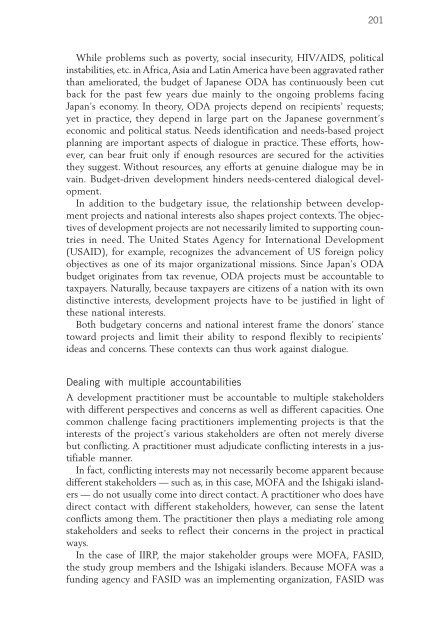Dialogue in Pursuit of Development - Are you looking for one of ...
Dialogue in Pursuit of Development - Are you looking for one of ...
Dialogue in Pursuit of Development - Are you looking for one of ...
You also want an ePaper? Increase the reach of your titles
YUMPU automatically turns print PDFs into web optimized ePapers that Google loves.
201<br />
While problems such as poverty, social <strong>in</strong>security, HIV/AIDS, political<br />
<strong>in</strong>stabilities, etc. <strong>in</strong> Africa, Asia and Lat<strong>in</strong> America have been aggravated rather<br />
than ameliorated, the budget <strong>of</strong> Japanese ODA has cont<strong>in</strong>uously been cut<br />
back <strong>for</strong> the past few years due ma<strong>in</strong>ly to the ongo<strong>in</strong>g problems fac<strong>in</strong>g<br />
Japan’s economy. In theory, ODA projects depend on recipients’ requests;<br />
yet <strong>in</strong> practice, they depend <strong>in</strong> large part on the Japanese government’s<br />
economic and political status. Needs identification and needs-based project<br />
plann<strong>in</strong>g are important aspects <strong>of</strong> dialogue <strong>in</strong> practice. These ef<strong>for</strong>ts, however,<br />
can bear fruit only if enough resources are secured <strong>for</strong> the activities<br />
they suggest. Without resources, any ef<strong>for</strong>ts at genu<strong>in</strong>e dialogue may be <strong>in</strong><br />
va<strong>in</strong>. Budget-driven development h<strong>in</strong>ders needs-centered dialogical development.<br />
In addition to the budgetary issue, the relationship between development<br />
projects and national <strong>in</strong>terests also shapes project contexts. The objectives<br />
<strong>of</strong> development projects are not necessarily limited to support<strong>in</strong>g countries<br />
<strong>in</strong> need. The United States Agency <strong>for</strong> International <strong>Development</strong><br />
(USAID), <strong>for</strong> example, recognizes the advancement <strong>of</strong> US <strong>for</strong>eign policy<br />
objectives as <strong>one</strong> <strong>of</strong> its major organizational missions. S<strong>in</strong>ce Japan’s ODA<br />
budget orig<strong>in</strong>ates from tax revenue, ODA projects must be accountable to<br />
taxpayers. Naturally, because taxpayers are citizens <strong>of</strong> a nation with its own<br />
dist<strong>in</strong>ctive <strong>in</strong>terests, development projects have to be justified <strong>in</strong> light <strong>of</strong><br />
these national <strong>in</strong>terests.<br />
Both budgetary concerns and national <strong>in</strong>terest frame the donors’ stance<br />
toward projects and limit their ability to respond flexibly to recipients’<br />
ideas and concerns. These contexts can thus work aga<strong>in</strong>st dialogue.<br />
Deal<strong>in</strong>g with multiple accountabilities<br />
A development practiti<strong>one</strong>r must be accountable to multiple stakeholders<br />
with different perspectives and concerns as well as different capacities. One<br />
common challenge fac<strong>in</strong>g practiti<strong>one</strong>rs implement<strong>in</strong>g projects is that the<br />
<strong>in</strong>terests <strong>of</strong> the project’s various stakeholders are <strong>of</strong>ten not merely diverse<br />
but conflict<strong>in</strong>g. A practiti<strong>one</strong>r must adjudicate conflict<strong>in</strong>g <strong>in</strong>terests <strong>in</strong> a justifiable<br />
manner.<br />
In fact, conflict<strong>in</strong>g <strong>in</strong>terests may not necessarily become apparent because<br />
different stakeholders — such as, <strong>in</strong> this case, MOFA and the Ishigaki islanders<br />
— do not usually come <strong>in</strong>to direct contact. A practiti<strong>one</strong>r who does have<br />
direct contact with different stakeholders, however, can sense the latent<br />
conflicts among them. The practiti<strong>one</strong>r then plays a mediat<strong>in</strong>g role among<br />
stakeholders and seeks to reflect their concerns <strong>in</strong> the project <strong>in</strong> practical<br />
ways.<br />
In the case <strong>of</strong> IIRP, the major stakeholder groups were MOFA, FASID,<br />
the study group members and the Ishigaki islanders. Because MOFA was a<br />
fund<strong>in</strong>g agency and FASID was an implement<strong>in</strong>g organization, FASID was

















![CynefinFramework final [Read-Only]](https://img.yumpu.com/19017304/1/190x135/cynefinframework-final-read-only.jpg?quality=85)